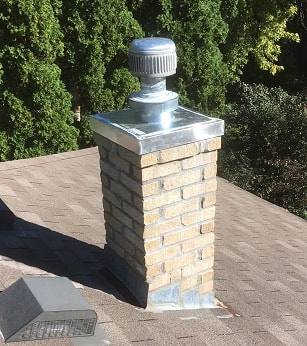 That is, your “other” chimney. Most homeowners do not realize that their water heater and most furnaces or boilers also have chimneys—more accurately referred to as flues. The purpose of the utility flue is to safely carry the byproducts of combustion out of the home. Both the flue and the chimney that houses it need to be routinely inspected and regularly maintained to ensure that they are dependably serving their intended purpose. Deterioration of either one may not be immediately obvious from the outside or at first glance with the naked eye. What’s the difference between a chimney and a flue? This can be a source of confusion, but the answer is simple: a flue is the duct or pipe that channels the byproducts of combustion (gases, soot, carbon monoxide, etc.) from the source of combustion (the appliance) to the outside atmosphere. The chimney is the external structure, usually masonry or stone, that houses the flue or flues, visibly peeking out above the roof line. There are many different appliances that require flues to vent, including furnaces, boilers, water heaters, and wood stoves, in addition to a traditional fireplace. A chimney can contain several flues, but no two appliances or fireplaces will share a flue, though they may connect at a point further removed from the source of combustion. (Sometimes customers calling a chimney sweep to book a cleaning will be confused by the fact that they are charged by how many fireplaces they have, not how many “chimneys” or flues. This is the reason—because each fireplace has its own flue.) Why do I need my flue cleaned? All flues, since they serve to vent harmful substances, need to be checked regularly to ensure their structural integrity, to clear any blockages, and to be cleaned of any debris or buildup. In a traditional fireplace flue, the buildup mainly consists of creosote. With oil-burning appliances, the buildup is caused mainly by soot, which needs to be regularly removed. Gas appliances are not as susceptible to soot buildup, as they tend to burn more cleanly, but they do produce sulfur, chlorine, and other acidic buildup, in addition to moisture, the combination of which causes corrosion. In addition to buildup, blockages are another important reason to have your flue cleaned. Blockages can result from leaves, sticks, and other debris falling into the chimney, and from birds and other wildlife building nests inside. Chimneys without caps are especially susceptible to these types of blockages. Another reason for blockage, though not as common, is through the deterioration, crumbling, or breaking down of the chimney’s interior structure over time. Any kind of blockage will hinder safe exit from your home of the byproducts of combustion, posing both a fire hazard and the risk of carbon monoxide poisoning, making regular cleaning and inspection critical. What is the process for cleaning a flue? A utility flue cleaning is similar to a fireplace flue cleaning (or chimney sweeping) and utilizes similar tools. Once access is gained to the flue by disconnecting the vent pipe from the burner, a vacuum is connected at the bottom to catch the loosened debris. The flue itself is often swept with a chimney cleaning rod and brush. In cases where where the flue enters a chase, which would involve a 90-degree bend and thus prevent usage of a rod, a flexible chimney cleaning system, such as the Viper GFK, may be utilized, or a tentacled air whip, such as the Viper Clean Sweep. These can easily maneuver around twists and turns, jostling debris loose as they go and helping to clear any blockages. The final step of the flue-cleaning process, at the hands of a diligent technician, would be to check for the presence of a flue cap and make a strong recommendation for one in the case of its absence. A flue cap, or chimney cap, is essential to protecting the integrity of the chimney, the flue, and their interior structure, and it will prevent most blockages. Look at it this way: lack of a chimney cap is akin to having a hole in your roof. So, what is best practice? Have your utility flues cleaned (or at least looked at) when you have your chimney swept, or at least once every two years. And show them how much you appreciate all they do for you by putting a cap on them! Note: most newer, high-efficiency furnaces and water heaters do not vent via a flue through the roof but rather are power-vented through PVC pipes that go straight out the side of the home. This type of venting is not the subject of this article. Wanna dig deeper? Download our free tipsheet: 5 Questions to Ask Before Hiring a Chimney Cleaning Company. Download Tipsheet Many thanks to our technician Ben S. for lending his expertise to this article.
0 Comments
Your comment will be posted after it is approved.
Leave a Reply. |
SearchArchives
April 2022
|
Twin Cities Furnace Cleaning - Open 7 Days a Week 8AM to 8PM
